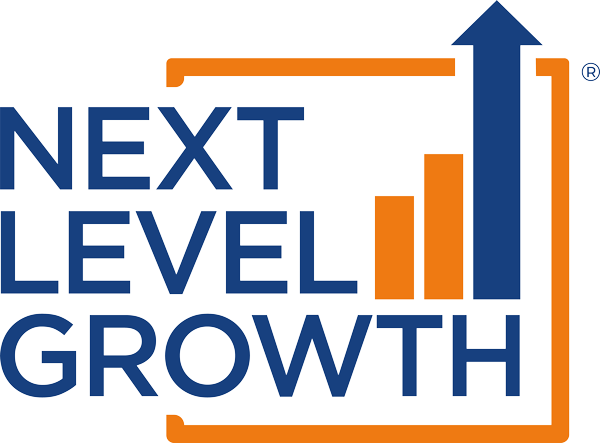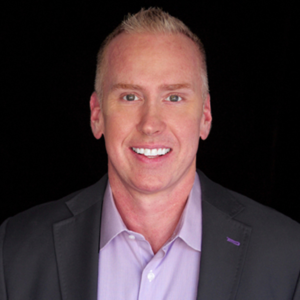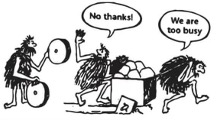
“It’s dangerous not to evolve.” Jeff Bezos
Over the last ten to fifteen years, the concept of entrepreneurs “systemizing” their businesses and using a “Business Operating System,” has become exponentially more mainstream and attainable. In general, regardless of the system used, an intentionally systemized business should consistently outperform any competitors who lack an intentionally organized system on which to operate the business as a whole.
But to understand and confirm which system is optimal for you and your organization, whether you’re already using one or not, it is important to understand the evolution of Business Operating Systems. If you are already using a Business Operating System like EOS®, Scaling Up®, or others, this article will help you either confirm that you’re using the right one for you and your organization, or help you discover if there is a better option out there for you. It will take you back to the early beginnings to help you understand how these systems evolved, what key differences exist between the more popular ones (to help you gain clarity on which one is most optimal for you) and explain the differences between a prescriptive system and a principled approach.
Why Do I Need a Business Operating System?
“Every system is perfectly designed to get the results it gets.” W. Edwards Deming
Whether you realize it or not, your business already is an “operating system,” whether that is by default, having organically taken shape as the business has grown, or by intentional, well thought out design.
- If your business is not growing as fast as you want it to, your business is a system designed by default to grow at a slower rate than you would like.
- If your business is not as profitable as you would like, your business is a system designed by default to generate a lower profit than you would like.
- If you struggle to find and keep good employees and your people are driving you nuts, then your business is a system designed by default to find and retain people who are not of the caliber you need, and therefore, they drive you nuts.
- If you struggle with customer or client attrition due to inconsistencies with your products or services, your business is designed by default to produce inconsistent outcomes which drive away your customers or clients.
What is a Business Operating System?
A Business Operating System is basically an organized set of processes through which a business manages strategy development and execution to guide the energy and focus of people within the organization and achieve common goals as it grows.
Two of the more well-known systems in the market over the last two decades have been Scaling Up and EOS®. Both systems are based on similar fundamentals and are generally prescriptive and static. More on this later.
The Evolution of Business Operating Systems – A Brief Overview
While the concept of systemizing a business has its roots as far back as the Industrial Revolution, it started to become more popular and formalized in the early 1900’s. One key figure in this development was W. Edwards Deming, an American engineer, statistician, professor, author, lecturer, and management consultant. Deming is widely credited with helping to launch the quality revolution in Japan after World War II through his work on statistical process control and his famous 14 Points for Management.
For those of you who appreciate history, other early thought leaders in the field of systemizing businesses were:
- Frederick Winslow Taylor: Known for his work on scientific management, Taylor’s ideas emphasized the scientific study of work methods to improve productivity. His book “The Principles of Scientific Management” (1911) is a seminal work in this field.
- Henry Ford: While primarily known for revolutionizing the automobile industry with his assembly line techniques, Ford’s ideas also had a significant impact on the concept of systemizing business operations. He was President of Ford Motor Company from 1906 to 1919.
- Peter Drucker: Drucker was a management consultant, educator, and author, often referred to as the “founder of modern management.” His book “The Practice of Management” (1954) is a classic in the field and covers various aspects of managing organizations, including the importance of systematic approaches
- W. Edwards Deming: Deming, as mentioned earlier, was a key figure in the quality revolution in Japan. His book “Out of the Crisis” (1982) outlines his management philosophy and principles, which emphasize the importance of quality and continual improvement in business processes.
- Eliyahu M. Goldratt: Goldratt’s book “The Goal: A Process of Ongoing Improvement” (1984) introduced the Theory of Constraints, which focuses on identifying and improving the constraints that limit a system’s performance, leading to more effective systemization.
- Michael Gerber: Gerber is known for his book “The E-Myth Revisited: Why Most Small Businesses Don’t Work and What to Do About It” (Originally published in 1985), which emphasizes the importance of systemizing and standardizing business processes to achieve success and scalability.
- Jack Stack: In his 1992 classic, The Great Game of Business, Stack lays out the process for how he and 12 other employees from International Harvester purchased a part of the company that remanufactured truck engines, and took it from $16 million in annual revenues to over $1 billion over a twenty-five year period.
See our list of over one hundred recommended books for entrepreneurs, divided into 19 different categories.
Until Gerber released E-Myth, most of the research and writings on systemizing businesses was focused on the operational aspects of the business, and especially on manufacturing. Gerber was among the first to focus on the organization as a whole and applying the idea of systemization to its entirety.
Gerber’s book addressed the common dilemma facing most entrepreneurs, that of being stuck as a technician in their own business. Many entrepreneurs simply don’t understand how to systemize things through the creation and delegation of process playbooks in order to get out of their own way and scale their business.
If you would like to learn about an affordable option to bring in a Lean Expert facilitator to help you get your business out of your brain and documented into outstanding playbooks, in just nine days instead of the nine months to nine years it takes companies to do it on their own, learn more about our friends at Process Optimizer®
Mastering the Rockefeller Habits
In 1991, just a few years following his founding of YEO (Young Entrepreneur’s Organization – now known as EO, or Entrepreneur’s Organization), Verne Harnish created the Birthing of Giants program, in partnership with MIT and Inc. Magazine. For the next ten years, Verne committed his time and energy to exploring and developing the foundational ideas that became known as the “Rockefeller Habits.”
In 2002, Verne published the book, Mastering the Rockefeller Habits. Two years later, shortly after the passing of my father, I joined the YPO (Young Presidents Organization) Southern Seven Chapter as President and CEO of our Veneer Manufacturing Business, Erath Veneer, and together with my Forum, we studied and implemented many of the tools and concepts from Verne’s book. I was thirty-two years old. While the book contained a valuable set of tools and concepts, they had not yet fully evolved into a holistic system, as they later would be when Verne published Scaling Up, Mastering the Rockefeller Habits 2.0.
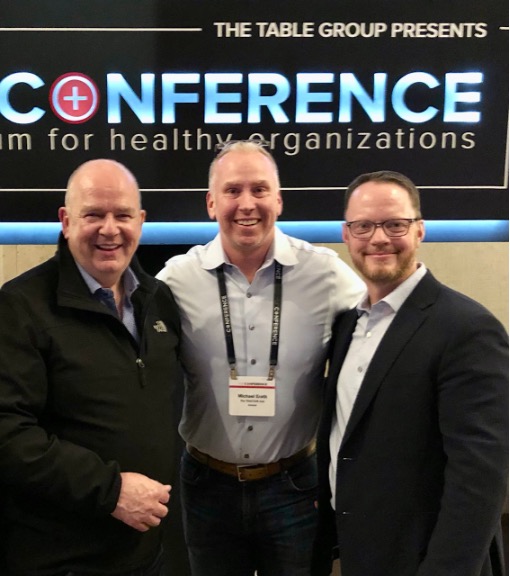
(L to R: Greg Cleary, Michael Erath and Duane Marshall at Patrick Lencioni’s 2020 UnConference)
During the late 1990’s, according to an article written by Verne Harnish, one of the founding members of the Detroit Chapter of YEO, Gino Wickman, who later went on to create EOS®, was using the Rockefeller Habits tools and techniques to turn around and eventually exit his family business. According to Verne, “He (Gino) later became one of our early coaching partners when we started (Gazelles). He specifically represented and exclusively used the Rockefeller Habits to coach other companies on behalf of my firm – and was an outstanding coach for us.”
As often happens in the entrepreneurial world, a person works for an organization, learns a set of skills, and in doing so comes up with either a better way to do things, or a way to solve problems they see as not being solved with the existing product. The courageous ones often go off to start their own business to make those improvements and take them to market. This is what Gino did sometime around the turn of the century, and what I did with two close friends and important colleagues, Greg Cleary and Duane Marshall, some 20 years later.
Traction
According to Gino’s LinkedIn profile, it was in September of 2000, after leaving Verne Harnish and Gazelles, that Gino took what he had learned and experienced to that point, and began evolving and creating what eventually became EOS, the Entrepreneurial Operating System. In 2007, Gino published the book Traction, a very impactful book that has been embraced by entrepreneurs around the world and has led to him scaling the organization that teaches his system (EOS Worldwide) to now have nearly one-thousand “implementers” in countries around the world.
In 2011, after transitioning from YPO to EO, again with a Forum Group I was in, we read and worked together to self-implement “Traction” in our own businesses. For me, this was a more applicable solution than the original Mastering the Rockefeller Habits, because the system was more holistic and there was a simple to follow path to implement the tools. Even so, based on my prior experiences as an entrepreneur, there were some parts of EOS where I felt the specific EOS tool didn’t “fit” my organization or culture, like their People Analyzer™. In other cases, during the course of my career and time in YPO, I felt that I had found a different tool, from a different system or thought leader, that would accomplish the same outcome but in an even better or more impactful way. As a result, I substituted out some of their tools in favor of tools and concepts which I felt were better suited for my organization or would lead to better results. In some cases I even created and added additional tools rooted in concepts from thought leaders like Jim Collins, Simon Sinek, Ken Iverson, and others, which I felt filled in some gaps that I found to exist within EOS.
Gino’s evolution in creating EOS, as laid out in the book Traction, was an important improvement because it provided a prescriptive and linear approach that made it easier to implement than Mastering the Rockefeller Habits. At the same time, while evolved, it was also limiting in that it had a defined starting point, a singular path through the system, and an ending point (graduation), from which point you are on your own, without additional and evolving resources to support you as you grow. In addition, it offered a finite toolbox of just 20 tools, which have not evolved in two decades. Deviating from the process was frowned upon, and if the system or process of implementation didn’t fit an organization, the organization was generally expected to bend and morph to fit the system, not the other way around.
Scaling Up – Mastering the Rockefeller Habits 2.0
In 2014, coming on the heels of the significant success of EOS and the book Traction, Verne Harnish released Scaling Up, Mastering the Rockefeller Habits 2.0. Verne’s new book was a further evolution of Business Operating Systems for two main reasons. It both incorporated more tools and concepts around strategy and cash, which many people felt were weaknesses of EOS, and instead of requiring a linear approach, Scaling Up allowed the user to take a non-linear approach by picking the area where they felt the greatest struggles, and working their way through the system in whichever order they felt was best.
By making this adjustment, while still a basically prescriptive system, taking a non-linear approach gave Scaling Up an advantage over EOS for those entrepreneurs who felt that EOS was a bit too restrictive and was boxing them in.
At this point, the world of Business Operating Systems had gone from a handful of great tools and ideas with Rockefeller Habits, to a holistic, prescriptive, and linear system (EOS), to another holistic, prescriptive, but non-linear system (Scaling Up).
The Birth of a Principled Approach
In 2015, after having lots of success self-implementing my own “customized” version of EOS in my own business, I began to exit that business and became certified as an EOS Implementer® in May of 2015. In the early days, because of my experience as a user and from my own personal journey as an entrepreneur – one of great successes, devastating failures, and a “reincarnation” of sorts, which I wrote about in my 2017 best-selling book, RISE: The Reincarnation of an Entrepreneur – I was very successful within the EOS community. In both my second and third years I broke the long-standing records for revenue generated as I ramped up early and fast. It was during that time that I met and grew to be very close friends with Greg Cleary and Duane Marshall, two other EOS Implementers who were among the most successful and tenured in the community.
During our time as EOS Implementers, we operated under a license agreement, which allowed us the flexibility to not only teach our clients EOS, but also work outside the system and teach them other tools and concepts as necessary to help them achieve their individual goals in ways that made the most sense depending on their unique culture and also relevant to their industry. That flexibility was in many ways key to the collective success Greg, Duane and I were having relative to other EOS Implementers.
Greg had even started a mastermind group called the Millionaire Coaches Mastermind Group, which consisted of around 25 of the most successful and entrepreneurial EOS Implementers at that time. Under the freedom of the license agreement we had with EOS, we collaborated and shared ideas around how to make improvements and additions to the ways we were working with our clients. It allowed many of us to begin teaching our clients additional concepts and providing them with new and improved tools so that we were able to evolve with them as they grew and add significant value for them beyond what otherwise should have been considered time for them to “graduate” from EOS.
In 2018, after scaling EOS from 1 to nearly 200 EOS Implementers, Gino sold a majority stake in the company to a Private Equity Firm. As is often the case, things began to change. Late in 2019, EOS Worldwide began a transition to a franchise organization. While this was a smart and understandable move for the Private Equity group that purchased EOS to make in terms of improving their valuation, the Franchise Agreement removed many of the freedoms that we had to be flexible with our clients in order to meet their needs. For Greg, Duane, and I, our values were no longer aligned with the organization where we had achieved so much success.
“Never be so sure of what you’ve got, that you wouldn’t take something better.” Chris Voss
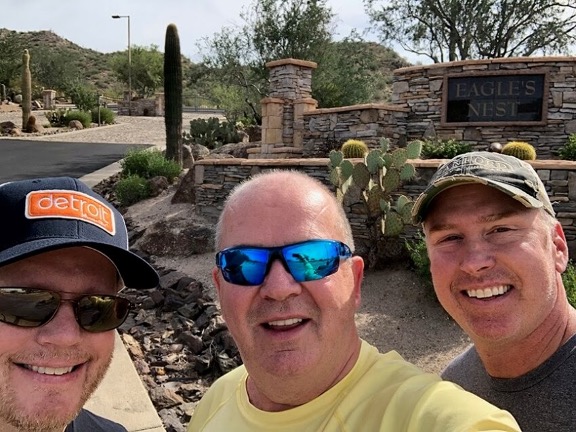
(L to R: Duane Marshall, Greg Cleary and Michael Erath after a hike near Michael’s home in Phoenix in 2019)
Next Level Growth and Pinnacle Business Guides
In November of 2019, after Greg and Duane had parted ways with EOS, and at a time that I was seriously questioning if I could continue under the coming franchise system, the three of us met for a long weekend at my home in Phoenix.
We spent the weekend working off of portable whiteboards by our pool and ideated on how we could take everything we had learned over our careers, break the mold of the typical, prescriptive systems and create a flexible framework based on principles that would solve the common frustration with Business Operating Systems being too “rigid.” It was that weekend that the concept of a principled approach was born.

In the beginning, Greg, Duane and I set out to form a partnership, and my official role was going to specifically focus on leading from the Finance seat, while Duane focused on Operations, and Greg on Marketing and Business Development. The three of us worked together to build and create the initial framework and the early-stage foundational tools, many of which were rooted in our collaboration from the Millionaire Coaches Mastermind Group.
Due to a personal family tragedy earlier that year, I was forced to disengage as we neared the formation of the legal entity that became Pinnacle Business Guides, and I was not able to make my return until the entity had already been formed and me re-joining as a partner was no longer feasible. To keep things simple and collaborative between us, we agreed that I would continue to build my own brand, Next Level Growth, in Phoenix and do so as a Firm of seasoned entrepreneurs turned Business Guides, who would all participate as active members of the Pinnacle community. In turn Pinnacle would leave growing the Phoenix-metro market to me and Next Level Growth.
In 2020, Pinnacle Business Guides and Next Level Growth, entered the market as the newest evolutions in the world of Business Operating Systems. Pinnacle and Next Level Growth are principle based and flexible, not prescriptive, making them more about the user and the outcomes desired than being just about the system. With Pinnacle and Next Level Growth, as with EOS and Scaling Up, the user gets a Business Operating System based on a core set of fundamentals. However, with Pinnacle and Next Level Growth, it is a system based on outcomes and the user following a principled approach, so that the resulting system is custom-tailored to fit, as opposed to a more rigid system requiring the user to adjust to fit the system.
From Prescriptive to Principled
Notice that I refer to Pinnacle and Next Level Growth as a ‘principled approach.” This is something that our friend and fellow Pinnacle Business Guide, Mark Whitmore, wrote about in a post on Linked In. “I’m thinking about the differences between prescriptive and principled – how the one is a list of actions, and the other is a set of ideas on which to build something. The first, prescription, tells you what to do regardless of who you are. Generic. Paint by number. Plug and play. There is no room for dynamism- simply pull these levers and follow these instructions and you will get these results. Check-the-box predictability.”
A principled approach, however, opens up a wide array of possibilities. While a principled approach still requires basic fundamentals, it allows the user to be creative, to select the right tools and concepts to achieve the principle based on what is right for the organization, regardless of the source of those tools or concepts. A principled approach is entrepreneurial. It also presumes that the entrepreneur ultimately knows what is best for his or her organization, versus a prescriptive system, which presumes that the system, and its creator, knows what is best for every organization.
A prescriptive system is limiting. There is a strict protocol to follow. For many organizations that is good enough. But if you’ve never been challenged and mentored to think with a 10X mindset, if you’re not sure what really is possible for you and your business, if you want to build something truly elite, you will eventually need the freedom, flexibility, and creativity that comes with a principled approach and an Expert Guide (think of a Guide like a Sherpa, helping you up Mt. Everest). That is something you rarely find with a prescriptive system and an implementer or coach.
Pinnacle and Next Level Growth are founded on the same five basic principles that have been around for centuries, and will be around for many more to come, with some minor modifications and variations in each of their approaches. These principles are focused on the user – on outcomes, flexibility, and customization – not a prescription. The approach is system agnostic and while there are “best-practice” recommendations to guide you, in the end it isn’t about which tools and concepts you choose to implement. Instead, it is about you being focused on the right things to ultimately get the Big Outcomes you want, and more than just helping you get a better Return on Investment, it is ultimately about you earning a meaningful Return on Life.
At Next Level Growth we call this framework, or approach, The Five Obsessions of Elite Organizations®.
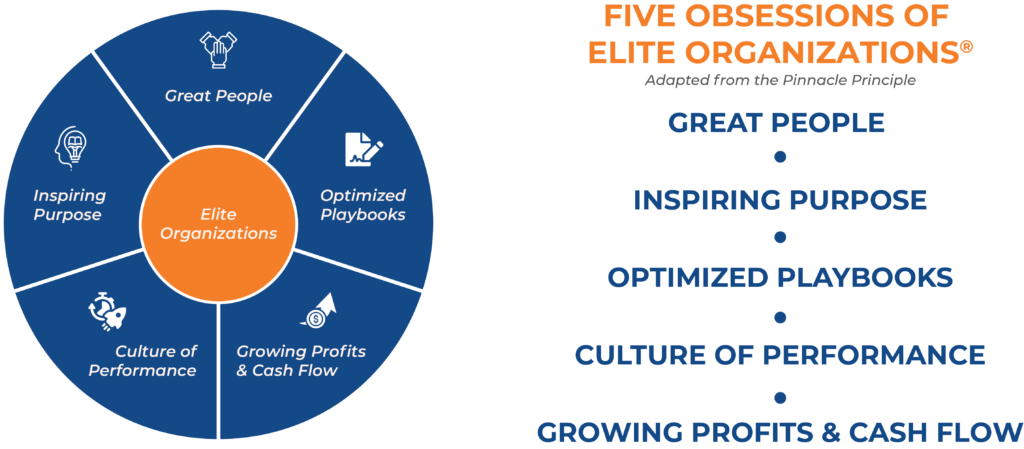
At our core, Next Level Growth’s team of elite Business Guides help entrepreneurs, and their leadership teams, build elite organizations by learning, operationalizing, and executing a disciplined focus on Great People, aligned around and driven by an Inspiring Purpose, consistently training on, executing, and improving Optimized Playbooks, in a Culture of Performance, while proactively Growing Profit and Cash Flow. These are the Five Obsessions of Elite Organizations. Would you and your organization be better off if you took a disciplined approach, together with an experienced Guide who has walked the path before you, to these Five Obsessions?
You can follow any of the links above to access a series of deep-dive articles and free downloads on each of the Five Obsessions so that you can begin using our tools, concepts, and principled approach in your own entrepreneurial business.
The Path to the Pinnacle
In 2023, Greg and Michael teamed up to write The Path to the Pinnacle, a book filled with inspiring stories of how clients of Pinnacle Business Guides and Next Level Growth have done unique things that are specific to their cultures and values to accel in each of these five principles. As I’m writing this article, I’m also deep into the creation of my third book, with the working title Five Obsessions of Elite Organizations®, which should be released in the first quarter of 2025. You can sign up to receive pre-release updates and specials through the link below.
Learn more and sign up for updates at FiveObsessions.com
Next Steps
Want to learn more about how to adopt a principled approach that will give you the freedom and flexibility to scale your business in your own unique way? Follow this link to explore the world of opportunity that opens up to you when you chose a principled approach over a prescriptive system, and feel free to connect with one of our Elite Business Guides to start a conversation if you have a burning desire to build something truly elite.
